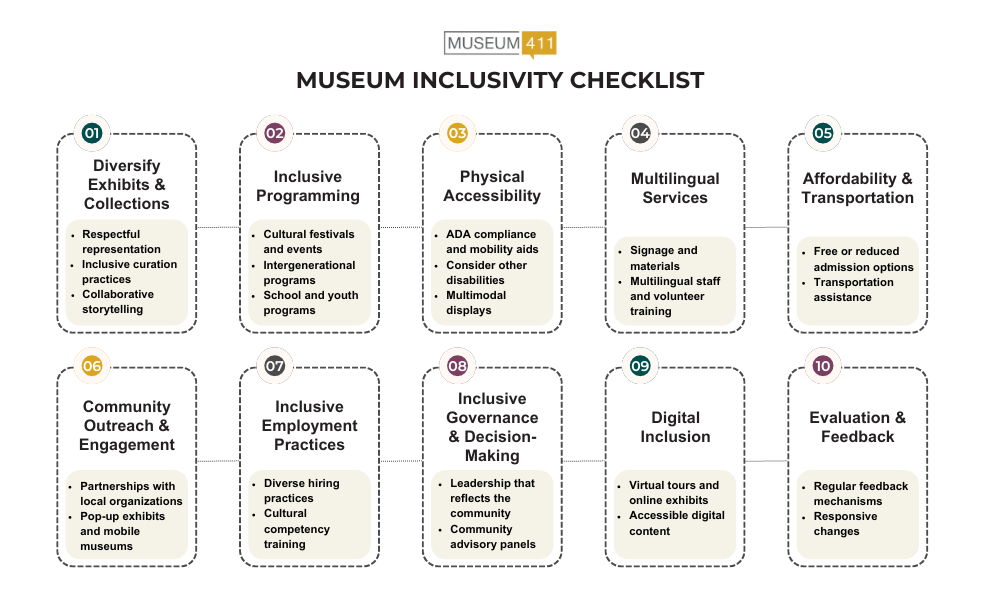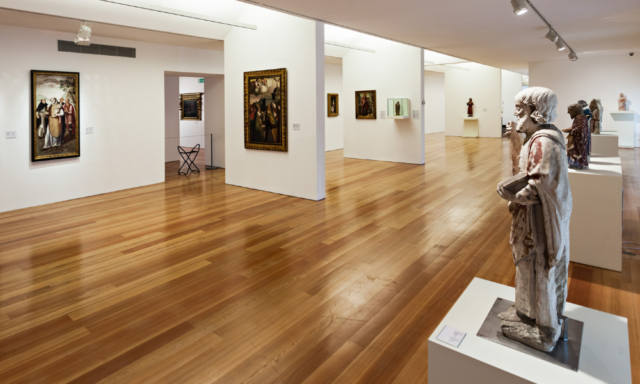To truly serve our communities, museums need to actively work towards accessibility and inclusion. The work requires an intersectional approach and attention to detail that may feel overwhelming at times but is ultimately critical to your long-term success.
Because inclusivity is so multifaceted, it can be useful to have a sort of rubric when ideating or auditing. Here, we’ve highlighted hallmarks of inclusivity in the museum sector plus tips for how to implement them.
Take this list and see how it can apply to your organization. Use it when brainstorming. Create standards for new projects. See where you can retrofit existing exhibits or programs. As with anything, the more you practice intersectional inclusion, the more it becomes second nature.

1. Diversifying Exhibits and Collections
Get into a diverse mindset for the big picture of your museum collection. Curate exhibits that showcase the histories, cultures, and contributions of various communities, particularly those that have been historically marginalized. Representation matters.
Notes on the diversification process:
It’s not just about including diverse materials and moving on to the next task — you want to ensure that exhibits, especially those depicting marginalized communities, are presented respectfully and accurately. Invite members of the featured communities into the narrative-building process to ensure your exhibits accurately represent their experiences and stories. This can even be a digital initiative, as the Smithsonian American Women’s History Museum does on its website, requesting the public to “Co-Create with Us.”
2. Inclusive Programming
Take a closer look at who makes up your community, specifically the cultures represented. Host festivals, workshops, and events that celebrate the diverse cultures in the area. When a visitor forges a truly personal connection to your museum, that tends to translate into lifelong loyalty.
Always keep age in mind. The American Alliance of Museums (AAM) has amassed a collection of resources for creative aging and museum programs for the older segment of our population. Dig deeper and think about designing programs that bring together different age groups to foster mutual understanding and respect across generations.
Partner with schools to develop educational programs that are inclusive and representative of diverse histories and perspectives. Look at the calendar for relevant dates and view curricula to see where your museum can enhance and expand on what’s being covered in schools.
3. Physical Accessibility
The more accessible your museum is, the more inclusive it is, full stop. When it comes to physical accessibility, most museums in the U.S. have a legal obligation under the Americans with Disabilities Act to provide ramps, elevators, accessible restrooms, tactile paving, etc. And though providing mobility aids like wheelchairs, scooters, and strollers isn’t required by law, you might try to find ways to provide such items (either a free, first-come, first-served option or as rentals).
And, of course, consider other forms of accessibility, like sensory-friendly areas for visitors with autism or sensory processing disorders. When space constraints prohibit the creation of a quiet room, make a sensory map so visitors can learn about hot spots. What about visitors who struggle in low-light situations? Perhaps a solution is a dedicated morning with higher-than-usual light levels?
Accessible exhibit design resources:
Think about a multimodal approach to exhibitions — incorporate a combination of visual, auditory, and tactile displays to cater to visitors with different abilities and learning styles. And always be mindful of exhibition text guidelines.
A page on your website highlighting accessibility features will help visitors prepare. Here’s a thorough example of accessibility options at the National Museum of African American History and Culture.
Access & Inclusion in action: To improve access for people with color blindness, the Center of Science and Industry (COSI) in Columbus, OH recently partnered with EnChroma for 12 pairs of color blind glasses that visitors can use for free. This option overlaps with COSI welcoming the traveling exhibit Nature of Color from the American Museum of Natural History in New York.
4. Multilingual Services
What languages are spoken in your area? Provide exhibit descriptions, guides, and educational materials in languages spoken by the community. Take it a step further, if possible, and hire or train staff and volunteers who can communicate in the languages of the local community, even if it’s just the basics.
The Modern Language Association has an interactive Language Map that uses aggregated census data to provide information on languages spoken in U.S. cities. Local schools also have a finger on this particular pulse and can be a resource.
5. Affordability and “Getting There”
Few museums can afford exclusively free entry, but see if there is room in the budget for free or reduced admission on certain days or for specific groups, such as low-income families, students, and seniors. Participation in Museums for All or Blue Star Museums might be an avenue for this.
What about offering a creative transportation solution? Is there a way to provide transportation options or subsidies for community members who face barriers in visiting the museum? From shuttles to partnerships with public transportation, think about potential solutions to what prevents your community from getting to you, literally.
Access & Inclusion in action: Check out details on the Detroit Institute of Arts free senior visits for adults 55 and older, which includes free bus transportation for groups of 25 or more.
6. Community Outreach and Engagement
Can you create pop-up exhibits or take mobile museums to different neighborhoods, particularly those that are underserved? The Perot Tech Truck is a great example of this, traveling to schools, festivals, and parks with ease.
It’s all about finding more ways to be part of the local community. Showing that your museum cares about the community it serves is a good short- and long-term strategy, and it benefits everyone. Collaborate with other local organizations to co-create programs and events that reflect the community’s interests and needs.
Access & Inclusion in action: The Oshkosh Public Museum recently teamed up with the Oshkosh Community Pantry for a food and hygiene product drive hosted by the museum. Visitors who donated received free admission and the museum dedicated one night to a presentation on the history of food insecurity and the context of rising hunger in the community.
7. Inclusive Employment Practices
It almost goes without saying at this point, but actively recruit staff and volunteers from diverse backgrounds. As the AAM says:
Your museum’s recruitment, hiring, and employment practices are a reflection of your organizational priorities and values. As museums are increasingly taking up the charge to be more inclusive and reflecting on the historical inequalities that have shaped the field, it is essential to critically examine and modify these practices to reflect a commitment to providing equitable opportunities for all. (Source: AAM)
Relatedly, be sure to provide ongoing training for staff and volunteers on cultural competency and inclusive practices. We can always learn more and do better.
8. Inclusive Governance and Decision-Making
It’s become increasingly common for museums to create advisory panels of community members to provide input on museum policies, programs, and exhibits. Here’s a great, honest look at methods of creating community advisors and the pros and cons of each.
As with staff, you want to be mindful that museum leadership, including boards and any potential advisory committees, reflects the diversity of your community. And when we talk about diversity, let’s say on the advisory committee, we’re talking about activists, people who work in the sector in question, people of different races and cultures, students, professionals at different career stages, organizational leaders, those born-and-raised in your city or transplants … diversity comes in many forms.
Access & Inclusion in action: For anyone interested in a deep dive, here’s a transcript from the panel All Ears? How Museums Use Community Advisory Groups to Listen and Act towards Local Relevance and Engagement at the College Art Association, February 2023. Panel members candidly discuss personal experiences in creating advisory panels to guide community engagement.
9. Digital Inclusion
Virtual tours and online exhibits made major strides during the early COVID years due to necessity and have now become a pillar of accessible programming for museums. Successful virtual programming allows you to reach a wider audience and includes those who cannot visit in person.
Building virtual exhibitions from the ground up can seem like a daunting task. Break it down into steps and do some exploring — look at different platforms like Omeka, StoryMaps, Unity, Slices and investigate 360° cameras. If you desperately need technical help, consider looking to platforms like Upwork to outsource the harder stuff.
Note on digital inclusion: Whenever you embrace digital content, from websites to online exhibits, make sure it is accessible to individuals with disabilities by following web accessibility guidelines.
10. Evaluation and Feedback
Ah yes, evaluation and feedback. It’s a crucial component for success, and since you are hopefully doing it already, make sure to include opportunities for people to share thoughts on inclusivity in particular.
Fold access and inclusion topics into regular surveys, focus groups, and community meetings. And then, most importantly, make it a priority to act on that feedback and continuously strive for improvements according to the evolving needs of the community.
Too many museums disregard accessibility and inclusion or neglect to prioritize it. The goal should be to welcome diverse visitors, but also to reflect and celebrate the rich tapestry of the community, to provide experiences that don’t discriminate, and to make your museum a “friendly” experience for all.




